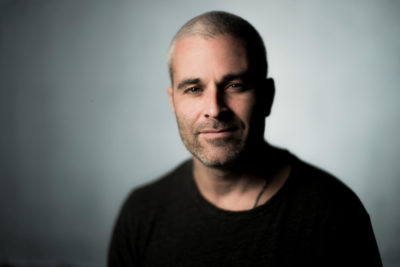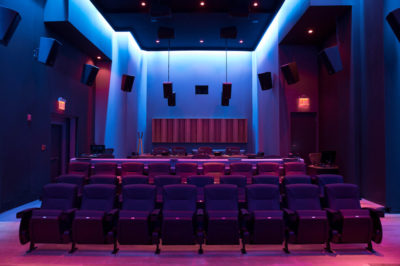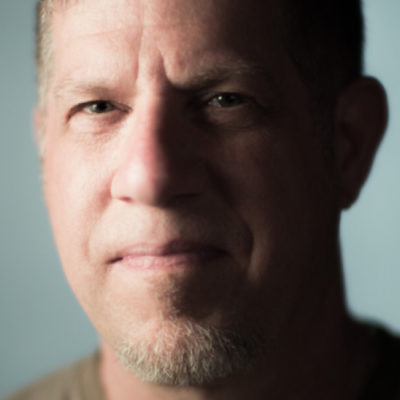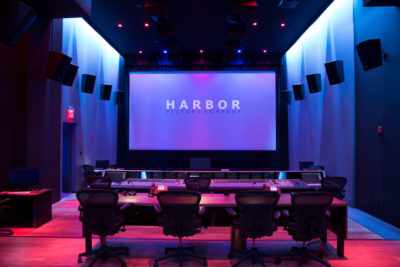Harbor Grand: Making NYC’s Maximum Film Mix Facility
The biggest thing in New York City audio post is truly a transporting experience.
Down in the deepest reaches of SoHo is Harbor Grand, a 4,500 square foot facility which stands as NYC’s only Hollywood-sized theatrical mix stage. The 2,500 square foot theater that it holds would be ample by the standards of any metropolis, but for Manhattan this is absolutely gargantuan: It has a 28-foot high screen, 26-foot ceiling height, and seating for 60. Armed with Euphonix System 5 and 6 consoles, this highly accurate surround environment is fully equipped to mix for IMAX and Atmos.
The origins of this flagship facility — which hosted its first mix in August 2015 and has been going strong ever since — would have been unexpected just a few years ago. The lineage reaches back to Harbor Sound a few blocks uptown on King Street, whose four mix stages shocked NYC with their arrival in early 2013 when they sprang up alongside the prolific full-service music company PULL.
Go back one more generation, and the grandfather of Harbor Grand is Harbor Picture Company, a comprehensive post production and production company founded by directors Zak Tucker and Theo Stanley in 2010. Early on, the pair probably never envisioned becoming responsible for attracting tent-pole features from around the world to mix sound in NYC – but that’s exactly what happened.
Although Harbor Grand hit the ground running, its long-term mission and odds for success have come sharply into focus in the time since its launch. Benefiting from their experience with the Empire State Film Post Production Tax Credit and the New York State Film Production Credit, Harbor Grand’s creators have seen their $2.5 million investment help to put NYC film mixing back on the map. That was no mean feat ever since the closing of midtown’s Sound One and it’s beloved, but dated, facilities.
How do you go big with all the challenges that come with expanding in The Big Apple? This in-depth interview with Tucker reveals the mix of determination, luck, and know-how that made Harbor Grand go.
Zak, now that you have projects under your belt and maybe some more perspective, the first question I wanted to ask you was what was the opportunity with Harbor Grand? What made you take the plunge to build it in the first place?
Leading up to Harbor Grand, we built several theatrical mix stages at our main location here in SoHo. The one thing that we kept finding was that the big tent-pole projects were having to go back to Los Angeles or to London to mix because there just did not exist in New York a tent-pole size and technology theatrical mix stage.
What happened was, if projects were posting in New York, when it came time for the final, we might do some of the temps and we might do some of the pre-dubbing here in New York, but when it came time for the final mix, they would have to pull back to Los Angeles or London because of just the scale of stages available. New York just did not have a tent-pole-scale mix stage.
You have all these world class mixers coming from London or Los Angeles and saying, “Look, if we’re going to deliver at the caliber we should be delivering at for those kinds of directors, we have to be in a scale mix stage.”
The other big part of it was that over the last several years, three-dimensional sound mixing in the sense of Atmos — Dolby Atmos was really coming to be defined as the standard. Once you got to a place where you had to be able to deliver an Atmos mix again, there was nowhere in New York that had the infrastructure or the scale to deliver Atmos for a tent-pole. Putting both scale size and level of infrastructure in terms of Atmos and Imax in one location was what really made us move forward with having the marquis tent-pole mix stage in New York.
Can you define a tent-pole stage? What characteristics does it have to have to qualify?
You’re looking at a few things. The main is that you want a stage that’s larger than 60-feet by 40-feet. Which is what our stage is, and you want a stage that has significant volume of air and ceiling height. The biggest stages in New York up until Harbor Grand have a 16-foot ceiling height. Our stage has a 26-foot ceiling height.
You get just a very different ability to push air that properly mimics a multiplex-sized movie theater. That’s the big thing is real, seamless translation between, especially for the big pictures, between the mix stage and the multiplex.
The Todd AO/Sound One stage no longer existed [see the story on its 2012 closure here], and so you saw there was a need. That’s still a big leap from seeing there’s a need to going ahead and filling this particular need: What happened to convince you to actually go ahead and be the company that would fill that need, and how you were able to get the space?
We spent two years searching all five boroughs for an appropriate space because you’re not only looking for a space that has that kind of volume, but it’s also got to be column-free, right? It also has to exist in a place that clients want to access. We looked in all five boroughs. We found one potential other suitable space in Brooklyn, but for us to be able to support it at the level that we support stages, it was very advantageous for us to have it much closer to home.
After two years of searching, we found this one particular space which is not easy to come by in New York that was three blocks from our main campus. I think the combination of doing that search and also spending quite a lot of time canvasing our studio clients, Disney, Warner Brothers, Dreamworks, Fox, and saying, “In terms of location, what would be the best for you?” They all said SoHo. Some of the clients were more resistant at that point to go into Brooklyn even though there might be the infrastructure there, they weren’t ready to go. They wanted it close.
The ability to interface with the rest of our post-production pipeline was key — so many of our shows were doing dailies, offline, visual effects, picture posts, sound posts. The ability to keep it all close and to make it all part of a larger offering is really what compelled us to be willing to make the investment and take the plunge.
It was really important to us that with the tax credit in New York, bringing so much work to New York, we wanted to make sure that the biggest, highest-end studio tent-pole post production projects would stay in New York. Without having that kind of sound offering, it wouldn’t be able to stay in New York.
Nailing the Space
Tell me about this space. It’s a former retail location, right?
That’s right. I think it had been vacant for a while, so I’m not sure what tenant was in there before. The reason why the space fit the bill was that it had been a very large column-free retail space. It wasn’t typical office space.
You said that you were searching extensively, but it wound up being so close. Were you not aware of it at first, or were you aware of it and it was a matter of making the numbers right?
It was a combination. We weren’t aware of it at first, and these are very hard spaces to find. It took a lot of negotiating to make sure the numbers could work to have that kind of space in what’s considered the highest-end, prime real estate in New York.
When we canvased our clients and the studios, both the directors and the editors and the mixers as well as the studios, they all made a strong case that locating it in Soho would be the most desirable place, and so we really listened to them and wanted to hold out for a space that would meet this criteria.
In addition to the stage itself, there are two additional 5.1 sound design suites that we built along with it that support the stage.
Why was SoHo in particular so important to them? It was not Midtown, not the Flatiron, not the East Village, not Bushwick, not Harlem. Why SoHo?
SoHo over the last five to eight years is where post-production for feature film and television has migrated to. You had Deluxe, you had TechniColor, and you had Harbor Sound all within several square blocks of each other. SoHo sort of became the nexus for post-production for long form for New York and moved out of Midtown.
The ability for the creative team, the director, the editor, and the mixers to easily move around, whichever facility they were doing the rest of their post at — to easily be able to access the stage was of critical importance. One of the things that significantly streamlines and affects budget is the ability to handle multiple post-production processes in a single day, and having created it, be able to move from one facility to the next. The ability to have that level of post-production serving all the main facilities in New York within walking distance was critical. On top of that, you just have easy access from every bus and subway system in New York stops within two blocks of the stage.
You also could think about that when you have visiting talent, whether it’s the directors or the editors or the mixers, when they come to New York, they want the New York experience. Being in SoHo means they can find accommodations for them just to live within walking distance to the stage.
A Bigger Build
You had built several mix stages before with Harbor Sound. What was the difference between turning this space into a mix stage versus the other smaller spaces that you had already completed?
I would say the overriding difference was scale. You’re talking about a stage that’s four or five times the size of the next largest stage, right?
Some specific considerations that came into play were, “A,” if this was going to be the premier marquis mix stage in New York, for example, the isolation was of critical importance. This is a stage that we floated, not on pucks but on a concrete rebar and spring-floated system, which was a significant investment and engineering hurdle to overcome so that we’d have complete isolation from street noise, subways, et cetera. We wanted it to be a premier listening experience.
Another big engineering hurdle about it is that because we have such extraordinary ceiling height — just in terms of construction methodology to work at double or even triple-height ceilings mean everything from hanging infrastructure like hanging the Atmos array and the Imax array as well. Working at that scale, it’s just another level of challenge. The same goes for having optimal climate control at that scale, all those things come together.
The other thing was that we also wanted to have a place that was a very welcoming environment and very boutique feel. What’s particular about this space is that between the stage and the two supporting rooms, when filmmakers are there, it’s really only their space. There’s not multiple shows going on there at once, and so it really becomes their private stage. That was part of what the challenge was.
How long did it take from the time you took possession of the space to getting it fully outfitted and ready for its first outside session?
It was a seven-and-a-half-month build — it probably extended two months longer than we would have liked. We were hoping for a faster build: People thought it would take a year, but we did it in seven months.
What were the challenges that came up that caused you to take longer?
Besides just construction and engineering challenges, there were significant permitting hurtles to overcome. Zoning issues around it.
I would say also that we got quite a lot of support from the state in terms of tax credit, so they gave us a tax incentive. The Empire State Development Commission was quite supportive in dealing with both the tax incentive component as well as helping us negotiate and navigate the zoning and building permit process.
Support/Systems
What is the notable technology that you were able to implement at Harbor Grand?
We went with Euphonix System 5, which matches the rest of our facility. The two-man mix setup. And obviously we were looking to build the premier acoustic environment for mixing tent-pole feature films: Not only did we implement and work closely with Dolby to implement the ideal speaker array for Atmos [7.1/5.1 as well as Imax], but we spent quite a lot of time, money, and engineering with Dolby in collaboration to perfectly array the speakers, and use the right speaker components.
Our Chief Engineer Avi Laniado also custom-modified the speakers so that we could really come out with what all of the tent-pole mixers who have come through have said: This is just really the premier listening environment that they’ve ever been in.
You talked about not just building the facility and it existing, but it was important for you to be able to support it in the ways that you support the previous rooms that you built for Harbor Sound. What does “great support” mean in this case?
We have from the start put forth the idea that robust technical and engineering support is critical to a mix experience. That’s why we bring in Avi who’s a 30-year veteran in mixing engineering support. We’ve also expanded the support team and brought on Duncan McRae, who’s coming onto the scene strong – he came up out of Australia and started with mix support for Chris Jenkins on Mad Max. He’s a big talent that’s coming up the pipe.
As opposed to a different approach which is like, “Here’s the stage, and we’ll see you tomorrow,” we have onsite high-end support and workflow design 24/7 supporting all of our stages.
You launched Harbor Sound in the spring of 2013. What did you learn from Harbor Sound that helped you with Harbor Grand?
That’s a good question. At a granular level, we really learned how to build a stage. By the time we got to Harbor Grand, we’d already built two mix stages and New York’s largest ADR stage. We learned a lot about construction methodology, what worked and what didn’t. That was something we really were able to bring to bear when we built a stage of that scale. That was a big part of it. Also in terms of workflow design and scalability and how we would move media around and what the requirements would be as we built a stage of that scale because it had to work, you know what I mean? The stage had to work because it was such a large investment.
We had to make sure that we’re not going to cut any corners and that we were going to make sure that both everything from the actual engineering of the stage, how we handled the isolation of the stage, the choice to go from a traditional puck float to a spring-floated floor was a big discussion that motivated us to go towards the spring-floated floor, as well as to understand how the people flow and how people would work on the stage and what kind of support stage we really would need.
It sounds like a logical progression. It would be hard to just open Harbor Grand first, right?
It would have been very tough for us to make that kind of investment because we wouldn’t have necessarily trusted ourselves in terms of what’s going to be required to make a stage, to engineer a stage of that scale at that time, from scratch.
I think you’re right that it was extremely helpful to have and also to be able to understand what the different offering would mean. We would be able to augment our offering and bring in and support a kind of project that up until that point we had not been able to support – we understood what the different requirements were, and what the different demands would be once you scale to that level project.
An Audio Post Newcomer
Zak, you weren’t always in audio post. You founded Harbor Picture Company, and for a long time, post was a service that you hired, right? You didn’t run it. How has your journey been in that respect going from being an audio post client to one who oversees it?
You’re right that our original DNA was on the picture side of feature film and television. It’s been quite an interesting journey and learning experience to bringing sound into the fold and into the offering.
Besides learning sound post-production, I would say what’s been most interesting is seeing what is possible when you’ve ranked all these different disciplines under one roof and seeing the creative and the budget advantage that results. For example, what I’ve seen is that directors are now able to work in a much more nonlinear and fluid way and to bounce between picture and visual effects and editorial in a much more nonlinear and fluid manner, which leads to creative insights and creative collaboration that did not happen before when all of those disciplines were siloed.
On the producing side, we’ve just seen significant cost savings from not having their creatives bouncing around town to different vendors and losing time in transport and in translation. We’ve also seen significant workflow and budget efficiencies in having one contact to handle all of the post needs and to coordinate the different facets of post-production. There’s no finger-pointing, and there’s a much easier hand-off both technologically and project management-wise between the different facets of post-production.
What would you identify has been the most challenging aspect for you and for the company of adding this business? What makes it complicated or challenging in ways that maybe you weren’t expecting or aware of?
One is that the sound team on a project tends to be significantly larger than the picture team on a project. Whereas on a picture side, you may have one or two conform editors, and conform is the analogous stage to sound editorial before you get to mix. On a sound editorial team, you might have as many as seven or 10 editors, right? That’s a much larger team and a much larger infrastructure requirement.
Similarly, when you get to the mix, on a typical tent-pole mix, you might have 10 people, 10 artists on the stage whereas on the picture side, you might have two. I think the scale of the team is a big difference, and the scale of the infrastructure required to handle sound is significantly larger.
That said, the process and the understanding of how a project moves through sound post and how a project moves through picture post are quite analogous.
Adopting Something Bigger in NYC
So what’s the trick to getting people to use a new facility? A lot of mixers and production teams are creatures of habit — aren’t they more prone to stick with what they know? How are you marketing it in New York and in LA and elsewhere so that people use the room?
I’d say it’s been a multifaceted approach. Our core as a company is that we are artist-driven. Our original, main thrust for getting the word out about the stage has been by introducing the stage to the key artists, mixers and the sound editorial teams. We’ve flown mixers and editorial teams in from Los Angeles so they could work on the stage and see the stage in New York.
We’ve toured the stage to all of the sound community so they would get the word out because we and they are committed to the artistic endeavor. Once they’ve experienced what they’re able to accomplish on that stage with the fidelity of that stage, the support of that stage, and the infrastructure that’s on that stage, they become the biggest advocates for pushing the projects to that stage because they want to get the most out of their project. Like other things in our business, relationships and word of mouth are sort of the biggest drivers. I would say the main way has been a very organic approach to getting the talent to be the advocates for the stage: Once they work on that stage, they don’t want to work anywhere else.
Did you see increased adoption in 2016? How are you measuring success?
I would say that the way we measured success is that the stage was scheduled to open on September 1st of 2015. Instead, by request we opened it in the middle of August, 2015, for the first project, which was an Oliver Stone picture, Snowden. The sound supervisor was Wiley Stateman, one of the top sound designers in the world. Since then, the stage has been dark two weeks.
Right after Snowden we did Ron Howard’s Inferno, which was mixed by Chris Jenkins, and supervised by Danny Pagan. After that, we went into Beauty and the Beast, which was mixed by Mike Minkler and supervised by Warren Shaw. It’s just been nonstop on the stage. The feedback and reviews we’ve gotten from these world-class artists is that it’s as good an environment that they’ve ever mixed in if not better. They’ve all given nothing but accolades about this stage and the support.
Harbor Grand obviously serves Harbor very well, but I want to make sure it’s clear that it’s also meant to serve the full New York post-production community. Unlike other business models which don’t allow other artists to come in and work there, by definition, we allow other artists to come in and work there.
It’s not only that Harbor staff mixers and editors work there, but we’re also really for visiting mixers and editors who need to bring their projects to a home that will support them in a way that they’re used to being supported.
There’s been plenty of hand-wringing over the state of audio, and the audio business overall in New York City, but it seems like a facility like Harbor Grand shows that there’s plenty of room for innovation and growth. What kind of mindset is required to open a facility on this scale? What do people need to do to put themselves in that position, say, “Hey, I’m going to grow things out, instead of just hunker down?”
I think you have to be thinking long-term, and you have to both be sensible and look at the numbers and make a good argument for the business proposition, but at the same time, you have to have a real love for sound post-production and be dedicated to wanting to elevate the craft and bring it to the audience that way. Otherwise, you just wouldn’t do it.
- David Weiss
Please note: When you buy products through links on this page, we may earn an affiliate commission.











